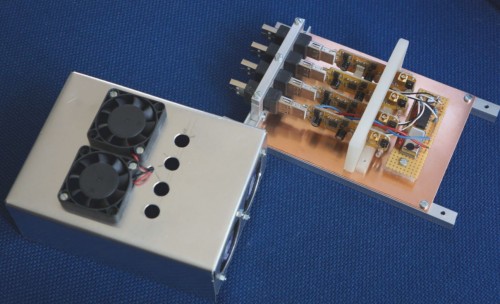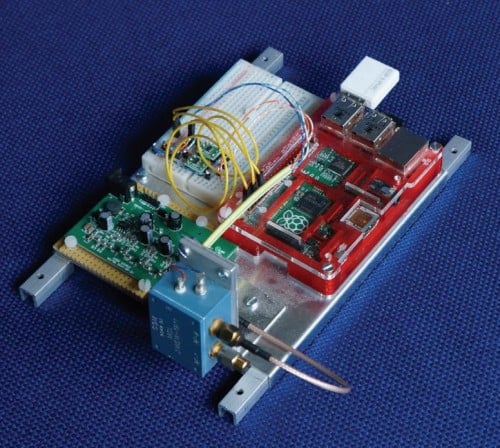Building a Quad RTL-SDR Receiver for Radio Astronomy
Amateur radio astronomer Peter W East has recently uploaded a new document to his website. The document details how he built a quad RTL-SDR based receiver for his radio astronomy experiments in interferometry and wide-band pulsar detection (pdf – NOTE: Link Removed. Please see his website for a direct link to the pdf “Quad RTL Receiver for Pulsar Detection”. High traffic from this post and elsewhere has made the document go offline several times). Interferometry is a technique which uses multiple smaller radio dishes spaced some distance apart to essentially get the same resolution a much larger dish. Pulsars are rapidly rotating neutron stars which emit radio waves, and the strongest ones can be observed by amateur radio telescopes and a receiver like the RTL-SDR.
The Quad receiver has four RTL-SDR’s all driven by a single TCXO, mounted inside an aluminum case with fans for air cooling. He also uses a 74HC04 hex inverter to act as a buffer for the 0.5 PPM TCXO that he uses. This ensures that the TCXO signal is strong enough to drive all four RTL-SDRs.

Whilst all the clocks are all synced to a single master clock, synchronisation between the RTL-SDR’s is still difficult to achieve because of jitter introduced by the operating system. To solve this he introduces a noise source and a switch. By switching the noise source on and off, correlation of the signal data can be achieved in post processing.


In the document Peter shows in detail how the system is constructed, and how it all works, as well as showing some interferometry results. The system uses custom software that he developed and this is all explained in the document as well.
admin, pdf has been moved, you may correct the link
http://www.y1pwe.co.uk/RAProgs/pdf/QuadRTLReceiver.pdf
http://www.y1pwe.co.uk/RAProgs/QuadRTLReceiver.pdf
hi
this link not work correctly , Please modify
tnx
It seems that his website (http://y1pwe.co.uk/) exceeded his monthly bandwidth allowance. I assume that it and the document will be back online next month.
It just worked for me
Wonderful. I am trying to guess what will be next; maybe a gravitational waves receiver using two RTL-SDR. A kind of homebrew LIGO 🙂